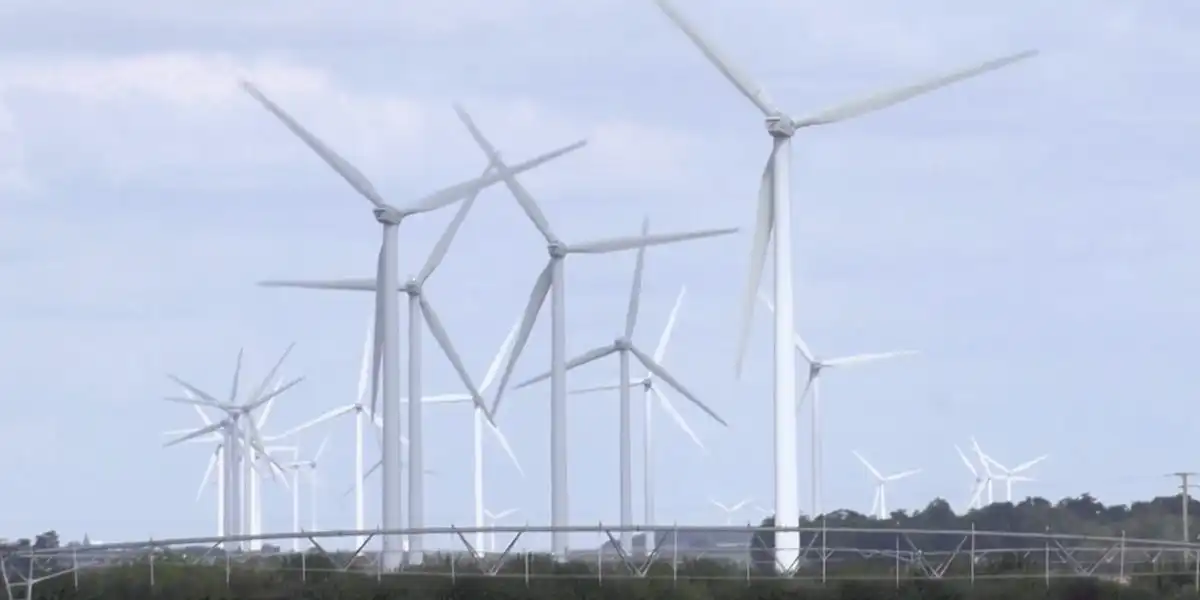Ooh! Neat. Now do America next.
They are focusing on gun power.
It’s more been white power
Freedom power
Hey if they are sending it to Ukraine fine by me
It has happened in America too from time to time. I don’t think it happens often anymore as there are things they can do to throttle windmills, connect to other grids,.and otherwise predict this. Nobody wins (not even the.consumer in the long run) when this happens so contracts get written to avoid it
Wait not even the customer? How?
You build wind turbines and do not use the electricity. So it might have been smarter to just not built them. At the same time, this is an important price signal to built more storage, grid connections and add felxible demand(with proper pricing system, so people actually do it).
Because negative price means they won’t have money to maintain their infrastructure and so in a couple years of cutting maintenance trying to stay working things fail when they are needed and then you don’t get power when you want it.
A negative price is almost always walled on both ends by solid positive prices. And a negative price does not mean a negative transmission fee. The price of producing electricity and the price of delivering it are separate things, at least in Europe. You’d still pay a little to the grid operator (who is typically forbidden from being an energy producer, except in emergencies) to receive the surplus energy.
Over here, negative prices typically happen when the weekend (industry is resting) is both sunny and windy.
During weekdays and nights, prices quickly turn positive again.
I would describe it as an incentive to store energy. If a storage plant has capacity, it will be pumping water uphill, charging batteries, heating a thermal store or making hydrogen / methane / whatever it makes (alas, there are very few such plants here). It will continue until there are many, so they can absorb the surplus.
Until then, consumers charge their cars (alas, only 1% of cars) and heat their sauna when it happens.
Yeah the theory of an actually smart grid is home and Industrial ai turning loads on and off to absorb over production and limit over demand - when automation is more evolved I think we’ll certainly see it in common use, remote devices charging their batteries at mid day and things like washing machines turning on
How can it be negative? Does the government pay you to use electricity? Or is it just a measure and you just don’t have to pay anything?
No in some cases, they pay you to use power in an attempt to keep the frequency stable. it takes time to ramp up or down power generation so the time where there’s almost too much power, the rate goes negative to attempt to level it out
It’s mainly happening during mid day where people aren’t home and using power and when solar is at its peak
And this is why it’s insane that we aren’t jumping on the ability to control devices like water heaters, heat pumps, and electric cars so they use power when electricity is cheapest…
We have soooo much energy storage capacity if we’re just a little smart about things.
Sounds like a good opportunity to invest into energy storage.
Basically if there is too much power going into the system it can damage transmission equipment, so they pay other grids or large users to accept some of the load. But these negative prices are usually for electricity wholesalers—prices for household consumers don’t usually change much and haven’t ever gone negative to my knowledge.
For households it depends on your contract with the energy companies. There are certain contracts which let you pay a fixed fee on top of market prices, but you’ll move with hour by hour fluctuations of the market prices. This might be interesting for those with smart homes who can schedule many of the more energy intensive appliances to run when prices are at expected daily lows. Or because you generally dont use much power in the expensive moments for your region.
These contracts however also remove most of the protection you enjoy from price spikes due to technical failures in the grid, or errors in weather prediction for renewables.
Interesting thanks for the added information. So a small number of people may actually be getting paid to turn all of their lights on and mine some bitcoin or whatever.
For a couple of hours last week I was paid to use electricity. Price of eletricity goes negative fairly often, but only a little. On top of the electricity I, having a spot priced contract, pay a margin ~0.5 € cents/kWh and tax and transmission fee. Last two are about 3 cents /kWh. So for me to get paid the price has to be about -7¢/kWh and that has only ever happened during a few hours.
Okay, this was more of a read than anticipated. Turns out there are a few systems that can allow negative pricing, at least one in Australia and one in Europe. It has to do with the European electricity exchange bidding process, by which wholesale customers place bids for power usage at specific points in time, which allows power generation to be balanced for usage and stability on both production and consumption sides (without integrated storage, all the energy generated needs to go somewhere). It lets large scale consumers reschedule their consumption to take advantage of when prices are low, and lets producers spin down production when demand is low.
What happens when it turns negative is there’s a sudden increase in production, usually due to solar or wind, sometimes flooding affecting hydroelectric, and the production of electricity is much higher than anticipated. Conventional power stations (especially coal) can take hours to restart after shutting down while costing significant sums of money, so it winds up being cheaper and safer for grid stability to keep less flexible power plants burning and reduce prices until wholesale customers are consuming the extra supply. Which can wind up meaning they’re outright paying people to use electricity.
In addition, Germany will export electricity to their neighbours to stabilize the grid. Ironically, according to the source I found (below), consumers actually wind up paying as part of the renewable energy surcharge that seems to guarantee that renewable energy is purchased at a steady rate regardless of electricity prices. Kind of a weird system, but it incentivizes building out renewable power and maintaining grid stability. Elon may be a tool, but adding battery storage into grids to slurp up excess supply and dispense it when needed is something that is exceedingly useful in getting the most out of renewable generation.
Wholesale rates. Someone normally selling is paying. Note that most wholesale power is under a long term contract and so not subject to wholesale prices. Thus overall your power comes from guaranteed price contracts ,but your rates are a bit lower because what the contracted power costs is low.
You still need to pay for transfer and energy tax so even when the price of electricity is zero (or negative) it’s still not free for the end user.
Here in Australia you get money for feeding energy back into the grid.
tried that for awhile in California then the power companies threw a fit …
Removed by mod
Nah, that’s the hole in the ozone layer giving everyone skin cancer
Negative prices mean the power companies start issuing orders to ramp down production and/or increase consumption. Residential users are generally not involved in all this because there’s not much they can do to help. It’s mostly between the power companies and large industrial plants that use more power in an afternoon than your home does in a year.
Someone with a coal or nuclear plant pays to keep transmitting power so they don’t have to turn it off.
Some (not great) subsidy schemes for wind also pay out regardless of market prices, but those are less common.
It means the corps selling at the ‘agreed upon prices’ are raking it in. Read further and you’ll find:
“But the negative prices signal an imbalance in the market and could discourage future investment in more energy infrastructure. Adjusting consumption patterns, such as when EV drivers charge their cars, could help smooth out prices.”
Can’t be letting the proles have cheap or free energy now, can we. How else are we supposed to know our place if we’re not scratching in the muck desperately trying to make ends meet?
Can’t wait to see this reflected in my electricity bill this month…
Is it dynamic billing that charges more or less depending on the grid load?
From what I’ve heard the futures are already bought by the energy companies so real time changes won’t funnel down. Like everything, once they have us all paying exorbitant prices they are not going to go back unless the government steps in.
My last bi monthly bill for electricity alone was €270…
But dynamic pricing would save energy companies money, as we could shift our energy consumption to when it costs less. That allows the energy companies to effectively sell more of their energy. I believe some places already do hourly dynamic billing. I’m sure there’s a markup over the industrial scale cost, but dynamic pricing would be better for both parties if people know and are able to shift habits accordingly.
Kinda what society wants and needs yet it’s the opposite of what these corporate gluts want.
deleted by creator
Wait, this is a good thing, right?
It basicly shows that renewables are able to produce more power then electricity demand at times. That means more electricity storage, flexible demand and a better grid is needed to use the currently wasted electricity. Especially the flexible demand is something a lot of other green technologies provide, like for example heat pumps having kind of built in storage with a hot water tank and evs have batteries anyway.
Basicly good news, but a long way to go.
Still, finally. Some actual good news. As little as it may be, it’s something. That better than what we see most days.
Sorta. Without good transmission and storage systems, producers will curtail their production and feel less inclined to invest in renewables since it’ll occasionally generate losses for them
That’s the problem with private generators feeding into a grid. If this was a co-op, public utility or other form of monopoly, easily idled generators like wind or solar are added or removed as required to balance the grid without consideration for whether particular units are profitable. An idled unit is also not wearing out.
As it is, there are all sorts of additional rules added to ensure that individual sources aren’t too heavily penalized when their particular technology isn’t profitable, like perfect wind conditions making thermal plants operate at a loss. That puts rates up for everyone.
Any Europeans to tell us how it is over there? Last I heard the gas prices were so high some dishes like fish and chips doubled in price.
Gas prices were high last autumn and then it was clear that there is a limited supply, but no shortages. Renewables and energy savings worked much better then most predicted. So it is not like things are completly awfull. What is a problem is the high inflation, especially in energy and food, which obviously hurts the poor the most. Obviously it is still Europe and there are system to take care of it a bit, but it is much worse then usual.
Next winter might be tight again, especially if it is a cold one, but basicly all new gas consuming projects have been rethought and are now not happening or some green alternative is being used. So propably a good thing it happend.
Electricity prices were crazy last winter (over 20c/kWh) but now they have been about what it was before the war (6c/kWh). Diesel price went from 1.4€/L to 2.2€/L and has now come back down to around 1.8€/L since the spring. All food prices are up too. Haven’t really affected my life but I make a good living and live cheaply anyways.
My monthly electricity budget is fixed at ~200€ per month, regardless of the electricity I use.
Then at the end of the year I get a bill for an extra 2000€ even though I didn’t use much at all and the company claims that I used 99.99% of my electricity during the one most expensive month of the year.
Then we have to call them and say “that is literally impossible, you are scamming us.” To which they reply “we can’t see what electricity you use, we can only estimate it.” (How are they even an energy company in that case of all of their numbers are made up guesses?)
Then we go through a song and dance of using our smart meters monthly tallies to prove definitively that our usage was much lower and evenlt spread so we should actually be barely paying any extra or getting money back.
To which they reply “we will lower it to only a few hundred, we do so much for you and you should be greatful we worked so hard to get you this price.”
This is Belgium. This is a real service conversation. Fuck Mega, Fuck their lying scamming bullshit “service” and I hope every executive of mega gets their bedroom infested with wolf spiders and gets bedbugs.
Negative prices are a bad sign in this. A good sign would be such a proficite affecting average and median prices, that is, being spread over time.
Such unevenness of production is the main problem with green energy. Except for nuclear, though it can have unexpected surges too, I know it’s a stupid joke.
It does effect electricity prices. For a non nuclear price comparison Germany and Poland are pretty good. Exchange traded price for Germany last June was 94.74€/MWh and Poland was at 118.17€/MWh. Germany has sometimes negative prices due to having significantly more renewables and that lowers prices.
Prices are there to show what infrastructure is necessary. This is basicly a sign for more variable demand and storage. Funnily enough a lot of the technologies currently used to electrify fossil fuels are somewhat variable demand like heat pumps and have some storage ability like evs. We need more green electricity anyway, so this is in no way a bad sign, but just a sign that there is an inbalance in built up between different green technologies. We most certainly need the power.
Prices are there to show what infrastructure is necessary. This is basicly a sign for more variable demand and storage.
Yes, that’s what I mean.
I honestly fail to see, how that is supposed to be a bad sign thou. It only shows that there is some overproduction at some times, usually weends with a lot of renewables. This is still not a daily thing to happen, even with solar being relativly predictable in summer. As it still does not meet work day demand in most places, althou it gets close.
Negative prices show overproduction and that is necessary to fill up storage, which is currently lacking. The good part is that overproduction drives down prices, whereas too much storage just costs money. So building generation first is the smart course of action. Looking aroudn, there are a lot of large scale batteries, variable demand consumers, such as electrolysis(for steel production) and large scale heat pumps with heat storage being announced. It is clearly working and leads to a further move away from fossil fuels. Can you please explain how that is a bad thing?
The good part is that overproduction drives down prices,
Only in the surge moments.
Negative prices show overproduction and that is necessary to fill up storage, which is currently lacking.
And show it through energy wasted.
Can you please explain how that is a bad thing?
If the consumers could adjust as fast at it’s needed, there would be no negative prices etc.
This means inefficiency.
Only in the surge moments.
So what? This still drives down average electricity prices, which is what really matters. Right now oversupply only really happens on weekends and during nights, when demand is low, and there are at least good condistions for renewables. For renewables to actually lower prices even more, you want those moments to extend. The issue is that the generation costs for fossil fuels are significantly above renewables, which are basicly at zero. Due to price being set by the most expensive plant currently producing you will not see low prices from renewables unless they meet demand. Most of the time they are unable to do so, unless demand is low and we have the higher fossil fuel prices.
In other words, we need more surge moments.
If the consumers could adjust as fast at it’s needed, there would be no negative prices etc.
This means inefficiency.
Actually the planned system is one with a bit of inefficency. When you built just enough renewables to produce enough electricity for the entire year, the electricity storage you need is insanly large. As you are basicly forced to built storage able to store electricity from sunny and windy summer days until no wind cloudy winter days. So from perfect conditions to absolutly worsed. The thing is there is usually some renewable electricity available at all time. A bit of wind somewhere and the clouds go away a bit during the day. So it is never totally zero for days and there are a lot of just okayish days. So you can use the power from just good days, for the really bad ones as well, which lowers your storage a lot. In fact most of the storage needed is basicly for a single night, which allows you to go most of the summer without fossil fuels at all. Basicly you overproduce a few percent more power, but cut your storage needs by 90% or so. To go most of the way you need storage for a single night. The rest can be long term storage, with less efficency like hydrogen burned in old gas power plants or biomass in coal plants. Obviously hvdc grids help a lot as well and they are built at speed. Norway and Sweden have insane storage capacity in form of hydro, which is intressting for the countries further south for example. Italy, Spain and Germany also have very different weather, which means different renewables power generation at times. That is also currently expended by a lot basicly everywhere in Europe.
In other words, this is a minor problem of loosing a few percent of generation for a bit until the systems are finished and a lot of the are built and planned right now. Without those prices the intrest in it would be lower thou. In terms of problems this is a very nice one to have and honestly good news. Certainly beats having to use fossil fuels all the time.
Norway and Sweden have insane storage capacity in form of hydro,
Yes, I’ve read about it, quite cool.
In everything else - I agree, just saying what negative prices right now indicate. I’ve actually meant exactly this - that there has to be sufficiently diverse and interconnected storage and the scale at which it all would even out.
Even end customers can benefit of it!!! 🤑🤑🤑
Oh no! Anyway.
Hey













